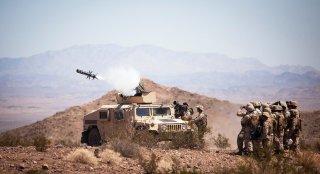Is America’s TOW Anti-Tank Missile Keeping Up with Modern Technology?
Despite its staying ahead of countermeasures, the design itself is getting dated.
Here’s What You Need to Remember: Despite its drawbacks, the TOW is a proven and reliable ATGM. The recent development and adoption of the radio-controlled TOW means that it’s likely to serve far into the future, even as armor-technology advances.
America’s TOW anti-tank missile has been one of the most enduring anti-armor weapons in the U.S. Arsenal.
First used to bust North Vietnamese tanks during the Vietnam war, the BGM-71 TOW has since served admirably in U.S. and foreign service. It’s the staple anti-tank guided missile of any U.S. mechanized formation, being mounted on the Bradley infantry fighting vehicles and a myriad of dedicated TOW missile carriers, such as the Marines’ LAV-AT.
But as the technology behind enemy armor advances, is the TOW keeping up?
Today’s TOW is a fairly far cry from the original missiles that served in Vietnam, featuring radio guidance (changing the “W” part of the original designation, from wire-guided to wireless-guided), tandem warheads, and ever more sophisticated firing posts. But even with all these upgrades, could the TOW be nearing obsolescence?
The way the TOW works is fairly simple. As a second-generation, Semi-Automatic Command Line of Sight (SACLOS) anti-tank missile, the gunner simply keeps crosshairs on the target and the missile guides itself onto the target.
It accomplishes this by means of an optical tracking (which is O in TOW) system. An infrared flare or two in the rear of the missile is tracked by the missile’s launching post, which references the position of the missile relative to the gunner’s aim point. Then, commands are sent through wire or radio link to the missile to correct it if necessary.
The missile is controlled in flight by four control surfaces at the midsection of the missile, two surfaces control vertical motion, and the other two control horizontal. The missile does not spin in flight, so control is simple. Two rocket engines at the midsection of the missile provide thrust. The engines are mounted in the midsection so as not to burn the guidance wires and to accommodate the infrared flare in the rear. Once the missile reaches the tank, a contact fuzed HEAT warhead goes off in the front, sending a shaped charge projectile into the tank’s armor.
The Soviet military recognized the threat that the TOW posed and started fielding counters through the 1970s. Composite armor that was more effective against HEAT charges was one of the first innovations, followed by explosive reactive armor that was incredibly effective against HEAT.
The TOW evolved as well to counter these upgrades. The Improved TOW (I-TOW) added a standoff probe that increased the effectiveness of the TOW’s single warhead, and the TOW 2A introduced tandem warheads. The latest TOWs, the TOW 2B, goes even further, installing a HEAT warhead that’s angled downwards and changing the missile flight pattern, so that the missile shoots it’s shaped charge projectile into the roof armor of an enemy tank (an innovation pioneered by the Swedish RBS 56 BILL missile).
However, in the 1990s the advanced Russian/Soviet “Shtora” active protection system entered service. This system used two powerful infrared spotlights (the “eyes” seen on T-80UK and T-90 tans) to jam the optical tracking mechanism. The spotlights would wash out the TOW’s infrared flare’s signal in the firing post’s optical tracker, preventing the missile from being guided past a certain point near the tank.
The TOW-2 introduced an upgraded flare to counter this. A visual encoder was installed on the flare to make it emit a pulsed coded signal that the firing post receptor was tuned to receive. This prevented “brute-force” jamming of the signal. Later a xenon beacon was also added, which emitted on two different infrared frequencies to make it even harder to jam. With upgrades, the TOW is immune to Shtora.
Despite its staying ahead of countermeasures, the design itself is getting dated. Traditional wire-guided TOWs face limitations when shooting across bodies of water and can’t shoot neat razor wire or downed power lines due to electrical effects on the control wires. Recent radio-controlled TOWs remedy this issue, at the cost of potentially being jammed by radio jammers on future tanks.
The other potential problem with the TOW is its speed. While the speed of a TOW has slowly been increasing, only so much can be squeezed out of the missile with its engine and control surface design. Current variants travel around 320 meters per second. This is slower than Russian systems such as the 9M123 “Khrizantema” (~400 meters per second), 9M120 “Ataka” (between 400 and 500 meters per second), and 9M119 “Svir” (around 350 meters per second). To contrast, modern tank rounds fly in excess of 1500 meters per second.
This means that in at ATGM duel, the TOW-equipped vehicle could be destroyed. It also means that TOWs will likely be intercepted by any hard-kill active-protection system, as the slow speed allows for easy interception. The U.S. military is aware of this deficiency and has tried ATGMs such as LOSAT and CKEM, which are much faster (CKEM reaching up to 2200+ meters per second).
Despite its drawbacks, the TOW is a proven and reliable ATGM. The recent development and adoption of the radio-controlled TOW means that it’s likely to serve far into the future, even as armor-technology advances.
Charlie Gao studied political and computer science at Grinnell College and is a frequent commentator on defense and national-security issues.
This article is being republished due to reader interest.
Image: Wikimedia Commons.

